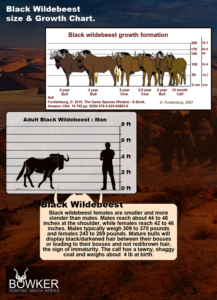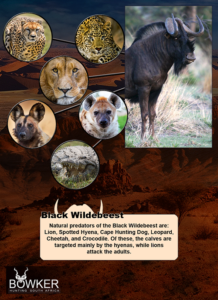Taxonomy notes:
Derivation of scientific name: Connochaetes is derived from the Greek word kónnos, which means ‘beard’, and gnou originates from the honking call they make, which is described as ge-nu. Common names: Black Wildebeest, White-tailed Gnu (English), Swartwildebees (Afrikaans), Gnu (Khoikhoi), Imbudumo (Ndebele), Podumö (Sepedi), Mmamononwane (Sesotho), Ingongoni (Swati), Mbutuma (Tsonga), Khongoni (Venda), Inqu (Xhosa), Inkonkoni (Zulu)

Description:
Black Wildebeest have a dark brown to black body, an erect mane and a long whitish tail. Both sexes have heavy, forward curving horns. Bulls measure 1.2 metres at the shoulder and weigh 161 Kg. Cows measure 1.16 metres at the shoulder and weigh 130 Kg. The horns of calves are initially straight, and start to grow the characteristic curvature at approximately nine months of age.

Distribution:
Black Wildebeest are endemic to South Africa. Historically the Black Wildebeest occupied the central open grassland plains of the country, from the Northern Cape, the Free State, the southern Highveld regions of the former Transvaal, western Lesotho, western Swaziland and the grassland areas below the Drakensberg in KwaZulu-Natal. It was also recently introduced to other parts of the country and neighbouring countries.

Interesting facts:
Black wildebeests were first discovered in the northern part of South Africa in the 1800s. Black wildebeests can run at speeds of 80 km/h (50 mph). When a person approaches a herd to within a few hundred meters, wildebeests snort and run a short distance before stopping and looking back. They will repeat this behaviour if further approached.
During cool weather, Black wildebeests lay down to rest, but in hotter conditions, they rest while standing up.
The herds of Black wildebeests graze either in line or in loose groups and usually walk in single file when moving about. They are often accompanied by Cattle egrets, which pick out and consume the insects hidden in their coats or disturbed by their movements.

Habitats and Ecology:
Black wildebeest occur in open Karoo and grasslands where they have access to water. Black wildebeest prefer areas with short grass, which they can feed on and which give them better visibility to be able to keep guard against predators. Open habitat with good visibility is also essential for reproductive behaviour; territorial males require unblocked views of their territories in order to breed.

Behavior:
This species shows strong attachment to particular areas, which are selected for all round visibility to enhance safety. Black wildebeest are mostly active in the early morning and late afternoon. When threatened they gallop around and stand with their forelegs on the ground whilst kicking with their hinged legs. They quickly run forward for a distance then stop to turn and look back to where they came from.
Mature bulls set up their own territories through which female herds often pass. These territories are maintained throughout the year. An encounter between two bulls involves elaborate rituals. During this ritual or afterwards, the two can toss their horns at each other, circle one another, or even look away. Then begins the fight. Threat displays such as shaking the head may also take place.
The gestational period lasts for about 8.5 months, after which a single calf is born. Females in labour do not move away from the female herd. Births normally take place in areas with short grass when the cow is in the lying position. She stands up immediately afterwards, which causes the umbilical cord to break, and vigorously licks the calf and chews on the afterbirth. In spite of regional variations, around 80% of the females give birth to their calves within a period of 2-3 weeks after the onset of the rainy season

Types of herds:
Black wildebeest form breeding herds of ten to 60 animals, within which three social groups are formed: one being the female herd made up of adults, sub-adults and calves. Then there is a bachelor herd made up of adult and sub-adult males. The last one is for the territorial adult bull. The bachelor herds move around whereas the female herds are strongly attached to home ranges. The territorial bull chases the bull calves away from the breeding herd once they are a year old and they then join the bachelor herd.

Hunting Black Wildebeest:
At first glance, hunting black wildebeest may seem rather easy, as on the open plains where he is often found, he will be relatively easy to locate. However, closing the distance on him may be an entirely different matter; his excellent senses and herd instinct make hunting black wildebeest quite a challenge.
Hunting black wildebeest is most likely best pursued during the morning or late afternoon while the herd is grazing. During cool weather, they will graze any time, but when it is warm, they tend to rest during the hottest part of the day.
Caution is the “watch word” when hunting black wildebeest, as he can be very aggressive when mating, disturbed, or wounded. Hunting black wildebeest in open terrain calls for a minimum of .270 calibre with a good 150-grain bullet. The 7mm mag or one of the .300 magnums is an even better choice. Follow the back edge of the front leg and place your shot one third up into the body, never more than half way up. Hunting black wildebeest in bushveld conditions may well call for even larger calibres, like the 9.3mm or the .375.

The Black Wildebeest Trophy:
Both genders have well-developed horns that have their origins in a thickened boss on the head and then extend forwards in a deep, downwards curve. As with the rhino, red hartebeest and warthog, the best trophy is not necessarily found on the oldest bull, but is rather found earlier when the bull is in its prime. This is due to the constant weathering of the horn during adulthood. Generally black wildebeest reach their maximum trophy status at an age of about 3.5 years.

What to look out for:
Sounds: These animals communicate with each other using pheromones detected by flehmen and several forms of vocal communication. One of these is a metallic snort or an echoing “hick”, that can be heard up to 1.5 km (1 mi) away. Spoor and droppings.

References:
Smithers, RHN, 1983. The Mammals of the Southern African Subregion, 1st edn. University of Pretoria, CTP Book Printers, Cape Town.
http://www.krugerpark.co.za/africa_black_wildebeest.html
http://animalia.bio/black-wildebeest
https://www.ewt.org.za/wp-content/uploads/2019/02/5.-Black-Wildebeest-Connochaetes-gnou_LC.pdf
Black Wildebeest / White-tailed gnu Connochaetes gnou (Zimmermann, 1780), Deon Furstenburg

